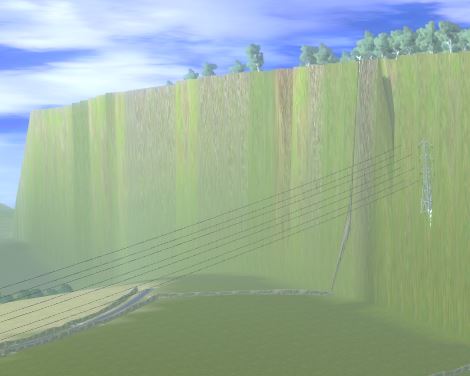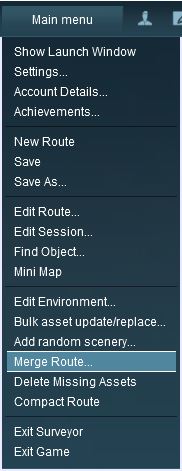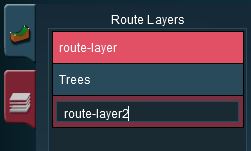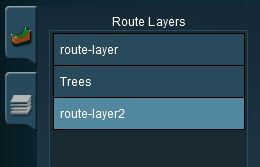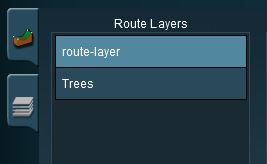How to Merge Routes
(→Selecting and Loading the Routes to Merge) |
(→The Merge Map) |
||
| Line 133: | Line 133: | ||
**'''Terrain Tab''' which is automatically selected when the MiniMap is first displayed. This shows the baseboards of the ''to-be-merged route'' superimposed on the baseboards of the ''base route''. A red background colour on this tab, as shown in the figure on the left, indicates that the two routes have baseboards that are in conflict - they are overlapping. The overlapping baseboards are shown in red on the MiniMap. | **'''Terrain Tab''' which is automatically selected when the MiniMap is first displayed. This shows the baseboards of the ''to-be-merged route'' superimposed on the baseboards of the ''base route''. A red background colour on this tab, as shown in the figure on the left, indicates that the two routes have baseboards that are in conflict - they are overlapping. The overlapping baseboards are shown in red on the MiniMap. | ||
**'''Layers Tab'''. This shows the layers that have been copied from both routes. A red background colour on this tab indicates that the two routes have layers that are in conflict. | **'''Layers Tab'''. This shows the layers that have been copied from both routes. A red background colour on this tab indicates that the two routes have layers that are in conflict. | ||
| − | <br>< | + | <br> |
| − | + | <table cellpadding="4" bgcolor=#ffffb0> | |
| + | <tr valign="top"> | ||
| + | <td>[[file:NotePad.PNG]]</td> | ||
| + | <td><font size="3">'''Notes:'''</font><br> | ||
*You can zoom the MiniMap in and out using the mouse control wheel. There appears to be no keyboard zoom control. | *You can zoom the MiniMap in and out using the mouse control wheel. There appears to be no keyboard zoom control. | ||
| − | |||
*You can move the centre of focus (the centre of the MiniMap view) by moving the mouse pointer to a new position and clicking with the right button. | *You can move the centre of focus (the centre of the MiniMap view) by moving the mouse pointer to a new position and clicking with the right button. | ||
| − | + | *The four arrows shown at the top, bottom and both sides of the map display can be clicked to move the '''''to-be-merged route''''' in the direction shown by each arrow.</td> | |
| − | *The four arrows shown at the top, bottom and both sides of the map display can be clicked to move the '''''to-be-merged route''''' in the direction shown by each arrow. | + | </tr> |
| − | </td> | + | </table></td> |
</tr> | </tr> | ||
</table> | </table> | ||
| Line 163: | Line 165: | ||
</table> | </table> | ||
<br> | <br> | ||
| + | |||
='''The Layers Map'''= | ='''The Layers Map'''= | ||
Revision as of 17:50, 8 July 2018
Contents |
Merging Routes
| The Surveyor Merge Routes command allows two different routes to be joined together - edge to edge. |
Before You Start Merging
| Make sure that you have backup copies of all the routes that you are going to merge. |
Before you start merging there are some important points you will need to consider and there may be some preparation work that will have to be performed.
Common Problems (and Their Solutions)
| Most route mergers will have problems but most of these problems can be easily fixed. |
Some problems will require you to do a bit (or a lot) of extra work before you can merge two routes into one. But for some problems, the best solution may be to select other routes to merge.
|
|
Selecting and Loading the Routes to Merge
- Load the Base Route into Surveyor
| DLC routes cannot be selected for merging |
This will display a "minimap" of the proposed merger (nothing will be merged until after the final step) with some control options.
The Merge Map
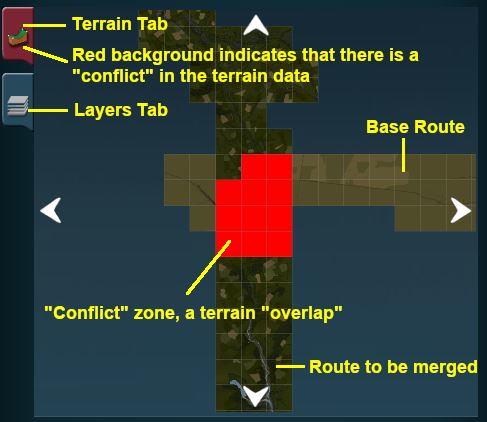 |
|
Move the To-Be-Merged Route into its New Position
 |
Click on the direction arrows shown at the top, bottom and sides of the MiniMap window to move the to-be-merged route into its correct position. Each click will move the to-be-merged route one baseboard in the selected direction.
In the example shown on the left, clicking the Left arrow 5 times moved the to-be-merged route 5 baseboards to the left to a position where there were no overlapping baseboards and all terrain conflicts were resolved.
|
The Layers Map
Click the Layers Tab to show the layers loaded from the two routes.
| A route merge will not proceed until ALL the terrain and layer conflicts have been eliminated. |
 |
In the example shown on the left two of the layers, one from each route, are using the same name "route-layer". This causes a conflict that must be resolved before the merge can be completed.
There are three simple options for solving this problem:-
|
| Delete one of the conflicting layers. Select the layer and click on the Delete icon. |
 |
|
| Merge one of the conflicting layers. Select the layer and click on the Merge icon (next to the Delete Icon). |
| CAUTION: When selecting a layer to merge into be aware that layers containing track objects such as signals, switches, speed signs, etc CANNOT be placed above a layer that contains the track. |
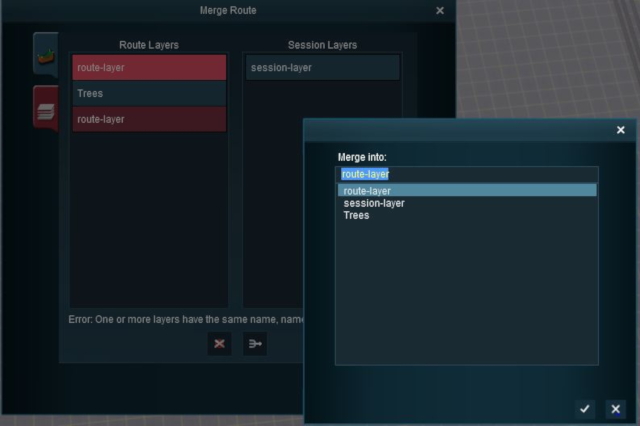 |
Then select the layer it will be merged into and click the Tick Icon. After merging ...
... the conflict has now been resolved. |
Accept or Reject
Once all the conflicts have been resolved, the final step in the merging process can take place.
| ACCEPT: Click the Tick Icon to accept the merge. This icon will not be usable unless ALL conflicts have been resolved. | |
| REJECT: Click the Cross Icon to reject the merge. The merging will be cancelled, no routes will be lost or altered. |
Trainz Wiki
- How to Guides
- Session Rules List (Alphabetical) with Parameters
- Session Rules List (Categories) With Parameters
Route Creation Tutorials:
Session Creation Tutorials:
- Adding Message Popups
- Adding Message Popups - Applications
- Adding Navigation Points
- Adding Navigation Points - Applications
- Configuring the Driver Setup Rule
- Controlling Junctions in Sessions
- Controlling Signals in Sessions
- Creating a HTML Asset (Session Introduction Page and In Game Messages)
- List of Parent Rules
- Parent and Child Rules
- Using Track Triggers
- Using Variables in Sessions - Examples
